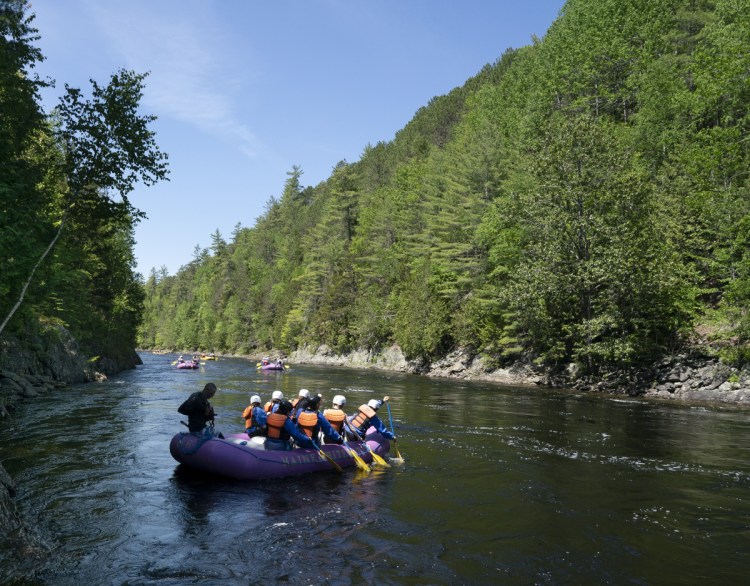We are writing in response to the Feb. 24 editorial in support of Central Maine Power’s proposed New England Clean Energy Connect transmission line (“Our View: Climate is top concern in CMP powerline case“). The newspaper’s support is based on an incomplete understanding of the costs and benefits of the proposed line.
We agree that climate change is the most serious issue facing our society. However, CMP has been unable to demonstrate that this project will provide additional climate-change mitigation benefits.
As noted by Dean Murphy, a witness for the Massachusetts attorney general before that state’s Department of Public Utilities, Hydro-Quebec will meet CMP’s needs with existing facilities and can do that by shifting power from current customers to Massachusetts. He stated, “Diverting clean energy from other regions to New England would enable a reduction in fossil generation and emissions within New England, but the reduced deliveries to other regions may need to be replaced by additional fossil generation in those regions. This would effectively substitute fossil generation in other regions for fossil generation in New England, shifting emissions from one region to another, without causing a material decrease.”
Without a clear demonstration that the project will result in real greenhouse-gas emission reductions at the global (not just regional) level, the project should not be approved.
However, even if NECEC would result in real climate change benefits, there is a better way to get this power to New England than carving over 50 miles of new corridor through Maine’s undeveloped forests. The editorial implies that opposition is driven by concern about visual impacts. While this may be true for some people, the primary concern for our groups and many others is the ecological impacts, which the editorial completely ignores.
Maine’s North Woods comprise a globally significant forest region notable for its lack of permanent development and high level of ecological connectivity. It is one of the largest areas of intact temperate mixed hardwood forest in the world. The Maine Department of Inland Fisheries and Wildlife has stated, “Northern Maine is unique as the largest area of undeveloped natural land in the eastern United States.” It is one of the few areas that is sufficiently natural to maintain viable populations of almost all native species, and is the last stronghold of native brook trout in the United States.
Both CMP and the editorial dismiss the region as “commercial forest.” However, Maine’s managed timberland retains the native forest composition, and the shifting mosaic of harvest units maintains a diversity of habitats that allows the continued movement of species through the landscape. The new corridor would create a permanent 150-foot-wide scar spanning the region. It would eliminate thousands of acres of existing and potential interior forest habitat through clearing and “edge effects” extending for hundreds of feet into the adjacent forest, and it would impede the movement of species that avoid open areas. It would also remove riparian forest cover adjacent to dozens of native brook trout streams and degrade wetlands and vernal pools along its length.
It would be far better for Maine and Massachusetts to get their renewable energy from sources closer to home. However, if large transmission lines are built, burial along existing roads would almost completely eliminate the fragmenting impacts of new corridors. Two competing projects in the Massachusetts Clean Energy request-for-proposal process – one in New Hampshire and the other in Vermont – included burial along existing roads for longer distances and under more difficult conditions than the proposed new corridor. This approach is both technologically and financially feasible, but CMP did not consider this option or show why it could not be used. While burial is more expensive, if we make cost the only consideration, we will be stuck with outmoded solutions to our renewable-energy needs.
Maine deserves better than to have its unique undeveloped North Woods degraded by a massive new corridor when there are less damaging alternatives. As we develop our 21st-century energy infrastructure we should look to 21st-century solutions, not the destructive approaches of the past.
Send questions/comments to the editors.



Success. Please wait for the page to reload. If the page does not reload within 5 seconds, please refresh the page.
Enter your email and password to access comments.
Hi, to comment on stories you must . This profile is in addition to your subscription and website login.
Already have a commenting profile? .
Invalid username/password.
Please check your email to confirm and complete your registration.
Only subscribers are eligible to post comments. Please subscribe or login first for digital access. Here’s why.
Use the form below to reset your password. When you've submitted your account email, we will send an email with a reset code.